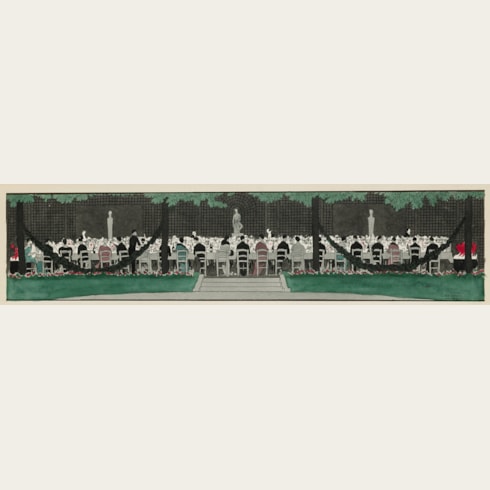André Edouard MARTY
(Paris 1882 - Paris 1974)
The Dinner in the Garden of Paul Poiret: L’Hôtel d’Antin illuminé
Signed and dated A.E. MARTY / Juin 1914 at the lower left.
194 x 486 mm. (7 5/8 x 19 1/8 in.) [image]
213 x 533 mm. (8 3/8 x 21 in.) [sheet]
The late 18th century Hôtel d’Antin was acquired by Poiret in 1909. As he recounts in his memoirs, ‘It was on a day in Mid-Lent that, wandering on foot in the fine quartier around the Champs Elysées, the Rue d’Artois, and the Avenue d’Antin…I stopped in front of a waste piece of land closed in by a railing. It was a deserted property beneath vast and probably 100-year-old trees, the grass grew wild, chickens pecked about in every corner, and through the railings one could see all the cats of the quarter wandering in search of prey…I persuaded the concierge to talk: The house had been abandoned for fifteen years. It had to be taken as a whole, and it was too big for a tradesman, while no private person wanted to repair these ruins, these fallen cornices, this roof that threatened to collapse. Two days later I signed my lease. I undertook repairing works that lasted three months – they seemed interminable. I had the garden made like those I had seen at Versailles, and in the great châteaux of France. By the first of October the house was transformed: I had respected its august character, one would have thought it the residence of a grand seigneur of another day. An embroidered parterre spread out like a tapestry in the midst of the alleys: there was a lawn bristling with multicoloured crocuses; there was a grassy amphitheatre leading to an airy room; there was a flight of three steps eighteen yards long, at whose extremity were two brazen hinds, light and leaping, two marvels I had brought back from Herculanum. All those who lived an hour in this enchanted setting will be touched by these evocative details. One entered the house by ten doors giving upon the steps, and on summer days all the reception rooms could be opened like a gallery on to the garden.’ The Hôtel d’Antin remained the centre of Poiret’s business ns creative activities until the end of 1924.
Poiret established his atelier in the Hôtel d’Antin, showing his collections in three salons on the ground floor, and had the garden façade drawn in a roundel by Georges Lepape that was used as a logo on his delivery boxes. The couturier also became famous for the lavish parties and dinners he hosted at the Hôtel d’Antin. As he later recalled, ‘I wanted to find means for keeping my friends near me, and creating a centre that should be the capital of all Parisian taste and intelligence. I succeeded: when I gave a party, no one failed to answer my summons, no previous engagement could avail against my invitation...Naturally there have been people who have said that I gave these fêtes as an item of advertisement, but I want to destroy this insinuation, which can only have originated in stupidity.’ Indeed, Poiret became so well known for his parties that he was soon asked to help plan those of other people. After the First World War, Poiret began to host regular summer evening parties in the garden of the Hôtel d’Antin, which he named ‘L’Oasis’, and which he later also used as an outdoor theatre.
After the First World War Marty continued to provide illustrations for the Gazette du Bon Ton, as well as for Vogue, Femina, L’Illustration des Modes, Monsieur, Harper’s Bazar, Le Sourire and House and Garden, among others. He also illustrated around fifty books, most notably Henri de Regnier’s Scènes Mythologiques, published in 1924, and produced designs for posters for London Transport. Working with the Compagnie des Arts Français, established by the architect Louis Süe and the decorator André Mare, Marty contributed to the decoration of the Pavillon Fontaine at the seminal Exposition des Arts Décoratifs of 1925, for which he also served on the jury. Twelve years later, at the Exposition Internationale of 1937, Marty again worked alongside Süe on the decoration of the jardin d’hiver of the Pavillon de la Société des Artistes Décorateurs, painting four wall panels devoted to the subjects of Pole Vaulting, Horseback Riding, Basketball and Tennis.
Exhibitions of Marty’s work were held in Paris at the Galerie Georges Petit in 1912, the Galerie Levesques in 1913, and at the Galerie Lucien Vogel and the Galerie Devambez in the 1920s.
Provenance
Galerie du Luxembourg, Paris, in 1975-1976.\
Literature
Exhibition









